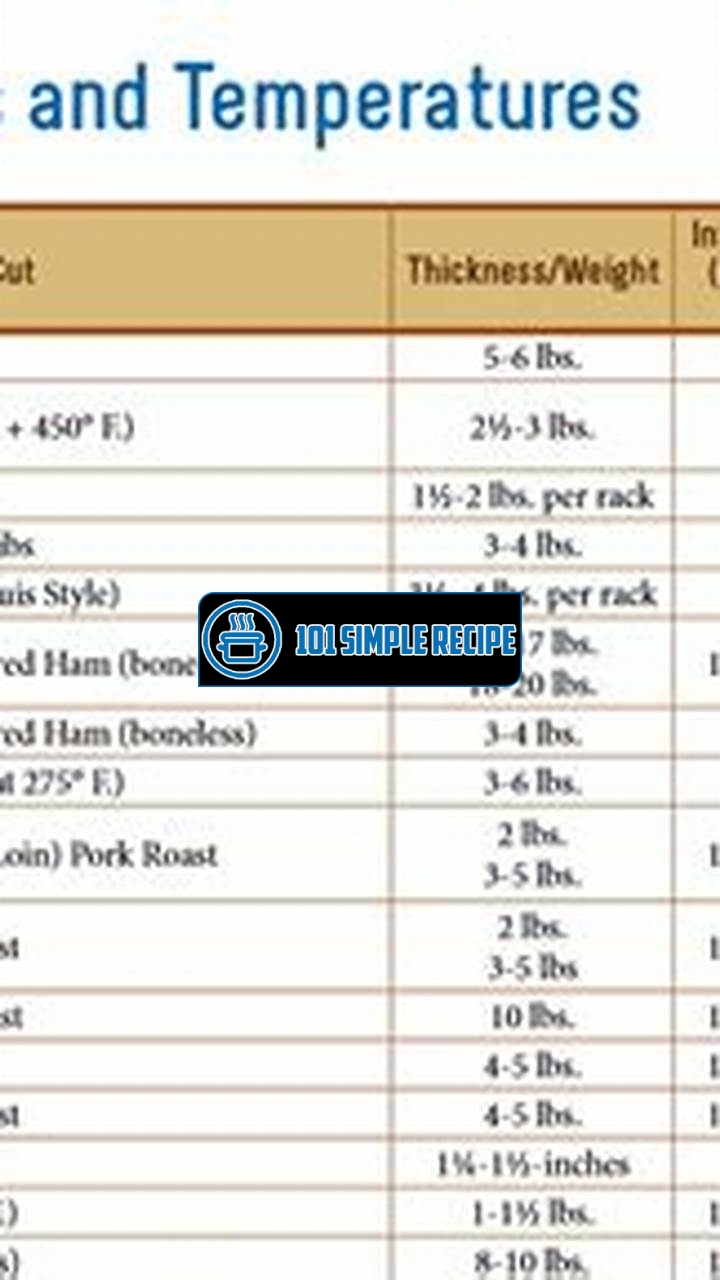If you’re a fan of tender and succulent pork, mastering the perfect pork loin roast cooking time is a must. Whether you’re planning a cozy family dinner or hosting a gathering with friends, nothing beats the aroma of a perfectly cooked pork loin roast. With the right cooking time, you can achieve a juicy and flavorful centerpiece for your meal. But how do you determine the ideal cooking time? In this article, we’ll guide you through the process, providing you with valuable tips and insights to ensure your pork loin roast is cooked to perfection every time.

Understanding Pork Loin Roast Cooking Time
When it comes to cooking a perfect pork loin roast, understanding the cooking time is crucial. The cooking time determines how long the roast needs to be cooked in order to achieve the desired level of doneness and tenderness. By mastering the cooking time, you can ensure that your pork loin roast is always flavorful and succulent.
It’s important to note that the cooking time of a pork loin roast can vary depending on various factors. These factors will be discussed in detail later in this article. However, by understanding the basics of cooking a pork loin roast and the factors that affect the cooking time, you can easily adapt your cooking technique to achieve consistent results.
The Basics of Pork Loin Roast
Pork loin roast is a popular cut of meat that comes from the back of the pig. It is known for its tender and juicy texture, making it a favorite choice for many meat enthusiasts. The pork loin roast is typically boneless and has a layer of fat on top, which adds flavor and helps keep the meat moist during cooking.
Before cooking a pork loin roast, it’s important to properly season the meat to enhance its flavor. You can use a variety of seasonings such as herbs, spices, and marinades to add depth and richness to the pork roast. Additionally, it’s recommended to bring the pork loin roast to room temperature before cooking to ensure even cooking throughout the meat.
Factors Affecting Cooking Time
Several factors can influence the cooking time of a pork loin roast, and it’s important to take these into consideration to achieve the perfect results. One of the key factors is the weight of the roast. Generally, the larger the roast, the longer it will take to cook. A good rule of thumb is to allow around 20 minutes of cooking time per pound of pork loin roast.
Another factor that affects cooking time is the cooking method. The most common methods for cooking a pork loin roast are roasting, grilling, and slow cooking. Each method requires a different cooking time and temperature. For example, roasting a pork loin at a high temperature will result in a shorter cooking time, while slow cooking at a lower temperature will require more time to achieve the desired level of tenderness.
The internal temperature of the pork loin roast is another important factor to consider. The recommended internal temperature for a cooked pork loin roast is 145 degrees Fahrenheit (63 degrees Celsius). Using a meat thermometer to measure the internal temperature will help you determine when the roast is cooked to perfection.
Measuring Internal Temperature
Measuring the internal temperature of a pork loin roast is crucial to ensure that it is cooked to the right level of doneness. To measure the internal temperature, insert a meat thermometer into the thickest part of the roast, making sure not to touch the bone. Once the temperature reaches 145 degrees Fahrenheit (63 degrees Celsius), your pork loin roast is ready to be removed from the heat.
Remember, the internal temperature of the roast will continue to rise by a few degrees after it is removed from the heat, so it’s important to take it out at the recommended temperature to prevent overcooking. Let the roast rest for a few minutes before slicing and serving to allow the juices to redistribute and ensure a juicy and flavorful result.
In conclusion, mastering the perfect pork loin roast cooking time requires an understanding of the key factors that influence the cooking process. By considering the weight of the roast, the cooking method, and measuring the internal temperature, you can achieve consistent and delicious results every time. So next time you’re cooking a pork loin roast, remember to pay attention to the cooking time and enjoy a mouthwatering and tender meal.
Selecting the Perfect Pork Loin Roast
When it comes to cooking a delicious pork loin roast, selecting the right cut is crucial. The cut of pork you choose will greatly impact the tenderness and flavor of the finished dish. To ensure a tender and flavorful outcome, follow these tips to select the ideal pork loin roast:
Understanding Different Cuts
There are various cuts of pork loin roast available, each offering unique characteristics. The most common cuts include:
- Boneless Pork Loin Roast: This cut is taken from the center of the pork loin and has the bones removed. It is lean and tender, making it a popular choice for many recipes.
- Bone-In Pork Loin Roast: This cut includes the bones, which add flavor and help retain moisture during cooking. It is slightly fattier than the boneless roast, resulting in a juicier end result.
Consider your personal preference and the recipe you plan to use when selecting between boneless and bone-in pork loin roast.
Considerations for Bone-In or Boneless
When deciding between bone-in or boneless pork loin roast, there are a few factors to consider:
- Flavor: Bone-in pork loin roast tends to have a slightly richer flavor due to the bones. If you prefer a more intense pork flavor, opt for the bone-in cut.
- Tenderness: Boneless pork loin roast is generally more tender as it has less connective tissue. If tenderness is your priority, choose the boneless option.
- Cooking Time: Bone-in pork loin roast may require slightly longer cooking times due to the bones. Keep this in mind when planning your meal.
Ultimately, choosing between bone-in or boneless pork loin roast depends on your personal taste preferences and cooking style.
Choosing the Right Size
When it comes to selecting the right size for your pork loin roast, consider the number of servings you need and the cooking method you plan to use. A general guideline is to estimate about 1/2 pound (225 grams) of pork loin roast per person.
Note: Adjust the portion size based on the appetites of your guests and whether you want leftovers.
If you are planning to roast the pork loin, a larger size may be preferable to ensure it cooks evenly and stays moist. On the other hand, if you are using a faster cooking method such as grilling or pan-searing, smaller cuts may be more appropriate.
Note: Regardless of the size you choose, always use a meat thermometer to ensure the internal temperature reaches a safe level of 145°F (63°C).
By carefully considering the size of your pork loin roast, you can ensure a perfectly cooked and satisfying meal for you and your guests.
Preparation and Seasoning
Discover the essential steps to prepare and season your pork loin roast for maximum flavor and tenderness.
Trimming Excess Fat
Removing excess fat from your pork loin roast is crucial to ensure it cooks evenly and prevents it from becoming greasy. Use a sharp knife to carefully trim any visible fat, leaving a thin layer to add flavor and moisture. Removing excessive fat will also make it easier to season and achieve a crispy exterior.
Marinades and Rubs
Marinating your pork loin roast can enhance its flavor and tenderize the meat. A marinade is a mixture of liquids and seasonings that infuses the meat with flavor and helps to break down its fibers, making it more tender. Consider using a combination of acidic ingredients like vinegar or citrus juice, along with oils, herbs, spices, and aromatics. Allow the pork loin roast to marinate in the refrigerator for at least 2 hours or overnight for maximum flavor. Alternatively, you can use a dry rub by coating the pork loin roast with a mixture of herbs, spices, salt, and pepper. The dry rub forms a flavorful crust on the meat during cooking.
Enhancing Flavors with Herbs and Spices
Herbs and spices play a vital role in adding depth and complexity to the flavor profile of your pork loin roast. Experiment with different combinations of herbs and spices to suit your taste preferences. Popular options include rosemary, thyme, sage, garlic powder, onion powder, paprika, and black pepper. You can either sprinkle the herbs and spices directly onto the meat or incorporate them into marinades or rubs. Remember to season the roast generously on all sides for even flavor distribution. ️
When seasoning your pork loin roast, keep in mind that the size and weight of the roast will affect the cooking time. It is recommended to use a meat thermometer to ensure the pork loin roast reaches the desired internal temperature. The safe internal temperature for pork is 145°F (63°C). Cooking times can vary, but as a general guideline, roast the pork loin at 325°F (165°C) for approximately 20 minutes per pound. Let the roast rest for a few minutes before slicing to allow the juices to redistribute and maximize tenderness. Enjoy your perfectly cooked pork loin roast with all its flavorful seasoning and juicy deliciousness! ️
Cooking Methods for Pork Loin Roast
When it comes to preparing the perfect pork loin roast, choosing the right cooking method is crucial. Different methods can yield varying flavors and textures, so it’s important to explore your options and determine which one suits your preferences and culinary skills best. In this article, we will delve into the three most popular cooking methods for pork loin roast: oven roasting, grilling, and slow cooking.
Oven Roasting
Oven roasting is a classic and reliable way to cook pork loin roast. It allows for even heat distribution, resulting in a juicy and tender roast with a crispy exterior. To achieve the best results, preheat your oven to 350°F (175°C) and season the pork loin roast with your favorite spices and herbs. Place the roast on a rack in a roasting pan, fat side up, and cook it uncovered. A general rule of thumb is to cook the roast for about 25 minutes per pound (450 grams) of meat. This should result in a beautifully browned and perfectly cooked pork loin roast.
Grilling
Grilling adds a unique smoky flavor to your pork loin roast, making it a favorite cooking method for many. Start by preheating your grill to medium-high heat. Season the pork loin roast with your preferred seasonings. Place the roast directly on the grill grates and sear it on all sides for about 2-3 minutes per side. Once seared, move the roast to indirect heat and continue grilling with the lid closed. The cooking time will vary based on the size of the roast, but it’s generally recommended to cook it for about 20 minutes per pound (450 grams) with the grill temperature around 325°F (165°C). Keep an eye on the internal temperature using a meat thermometer to ensure it reaches a safe minimum internal temperature of 145°F (63°C).
Slow Cooking
Slow cooking is perfect for those who prefer a hands-off approach to cooking. It allows the pork loin roast to cook low and slow, resulting in a melt-in-your-mouth tenderness. Start by seasoning the roast and searing it in a hot skillet to lock in the flavors. Then, transfer the roast to a slow cooker and add your desired liquid, such as broth or marinade. Set the slow cooker to low heat and let the pork loin roast cook for 6-8 hours. The extended cooking time allows the meat to become fork-tender. For a flavorful twist, add some vegetables and herbs to the slow cooker for a complete one-pot meal.
In summary, whether you choose oven roasting, grilling, or slow cooking, mastering the perfect pork loin roast cooking time is all about understanding the different methods and tailoring them to your preferences. Each method offers its own unique benefits, so don’t be afraid to experiment and find the one that suits your taste buds and culinary skills. So go on, get cooking, and impress your family and friends with a mouthwatering pork loin roast!
Cooking Time and Temperature Guidelines
When it comes to cooking a delicious pork loin roast, there are a few key guidelines that you must follow to ensure it turns out perfectly. From the recommended cooking temperatures to calculating the cooking time, and finally, the resting and carving process, each step plays a crucial role in achieving a tender and flavorful roast. Let’s dive into these details and master the art of cooking the perfect pork loin roast.
Recommended Cooking Temperatures
Cooking the pork loin roast at the right temperature is essential to achieve a juicy and tender result. The recommended cooking temperature for pork is 145°F (63°C). At this temperature, the roast will be juicy with a slight touch of pink in the center. However, if you prefer your roast well-done, you can cook it until it reaches an internal temperature of 160°F (71°C).
It’s important to note that cooking temperatures can vary depending on the size of the roast. For smaller roasts, it’s best to cook them at a slightly higher temperature to ensure they cook evenly. Larger roasts may require a lower temperature to avoid overcooking the outer layers while the center cooks through.
Calculating Cooking Time
Calculating the cooking time for your pork loin roast is crucial to avoid both undercooking and overcooking. As a general rule of thumb, you should allow approximately 20 minutes of cooking time per pound of meat. This estimate is based on cooking the roast at a temperature of 325°F (163°C).
However, it’s important to use a meat thermometer to determine the exact cooking time. Insert the thermometer into the thickest part of the roast, making sure it doesn’t touch the bone. Once the internal temperature reaches the recommended temperature based on your desired doneness, it’s time to remove the roast from the oven.
Resting and Carving
After removing the pork loin roast from the oven, it’s crucial to let it rest before carving. This allows the juices to redistribute throughout the meat, making it even more flavorful and tender. About 15-20 minutes of resting time is generally sufficient.
During this resting period, cover the roast loosely with aluminum foil to keep it warm. This will also prevent the meat from drying out. Once the resting time is over, it’s time to carve the roast. Use a sharp carving knife to create thin, even slices.
Note: It’s important to slice against the grain of the meat to ensure each slice is tender and easy to chew.
By following these cooking time and temperature guidelines, you’ll be able to master the art of cooking the perfect pork loin roast. Remember to use a meat thermometer to accurately determine the internal temperature and make adjustments based on the size of the roast. Resting the roast before carving is also crucial for maximum flavor and tenderness. Now, go ahead and impress your family and friends with your perfectly cooked pork loin roast!
Frequently Asked Questions
Here are some frequently asked questions about pork loin roast cooking time:
| No. | Questions | Answers |
|---|---|---|
| 1. | How long should I cook a pork loin roast? | The cooking time for a pork loin roast depends on its weight. As a general rule, cook the roast for 20 minutes per pound at 350°F (175°C). Use a meat thermometer to ensure the internal temperature reaches 145°F (63°C) for medium-rare or 160°F (70°C) for medium. |
| 2. | Should I cover the pork loin roast while cooking? | Cover the pork loin roast with aluminum foil during the first half of cooking to prevent the top from getting too brown. Remove the foil for the last part of cooking to allow the roast to develop a crispy exterior. |
| 3. | Do I need to baste the pork loin roast? | Basting is optional but can help keep the roast moist. You can baste the pork loin roast with its own juices or a mixture of melted butter and herbs. |
| 4. | Can I marinate the pork loin roast before cooking? | Yes, marinating the pork loin roast before cooking can enhance its flavor. You can use a marinade of your choice and refrigerate the roast for at least 2 hours or overnight. |
| 5. | How do I know when the pork loin roast is done? | Use a meat thermometer to check the internal temperature of the pork loin roast. It should register 145°F (63°C) for medium-rare or 160°F (70°C) for medium. Let the roast rest for 10-15 minutes before slicing. |
| 6. | Can I use a slow cooker for cooking a pork loin roast? | Yes, you can cook a pork loin roast in a slow cooker. Cook it on low for 6-8 hours or on high for 4-5 hours, until the internal temperature reaches the desired doneness. |
Thanks for Reading!
We hope this article has provided you with helpful information on cooking pork loin roast. Remember to adjust the cooking time based on the weight of your roast and use a meat thermometer for accuracy. Don’t forget to experiment with different seasoning and marinade options to customize the flavor to your preference. Happy cooking!
Jump to Recipe
Pork Loin Roast Cooking Time

Learn about the optimal cooking time for pork loin roast. Find out how to achieve a perfectly cooked and flavorful roast every time.
- 1 4-pound pork loin roast
- 2 tablespoons olive oil
- 2 cloves garlic (minced)
- 1 tablespoon chopped fresh rosemary
- 1 tablespoon Dijon mustard
- Salt and black pepper (to taste)
- Preheat the oven to 350°F (175°C).
- In a small bowl, combine the olive oil, minced garlic, chopped rosemary, Dijon mustard, salt, and black pepper. Rub the mixture all over the pork loin roast.
- Place the seasoned pork loin roast on a rack in a roasting pan. Insert a meat thermometer into the thickest part of the roast. Roast in the preheated oven for about 2 hours, or until the internal temperature reaches 145°F (63°C) for medium-rare or 160°F (70°C) for medium. Cover the roast with foil during the first half of cooking to prevent excessive browning.
- Remove the roast from the oven and let it rest for 10-15 minutes before slicing. This allows the juices to redistribute and ensures tender and juicy meat. Slice the pork loin roast and serve.
- If desired, use the drippings from the roasting pan to make a delicious gravy. Skim off any excess fat, then place the roasting pan over medium heat. Add some flour to make a roux, then gradually whisk in chicken or beef broth until desired consistency is reached. Season with salt and pepper to taste.






